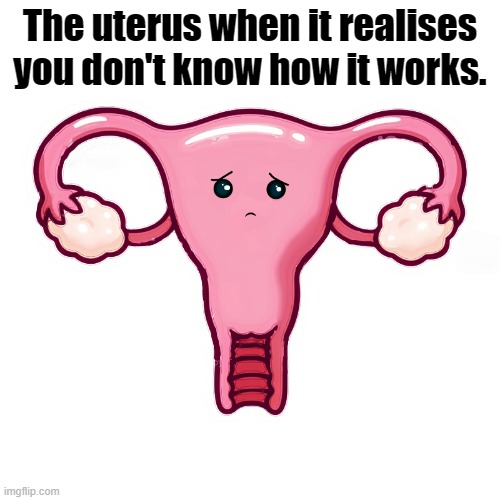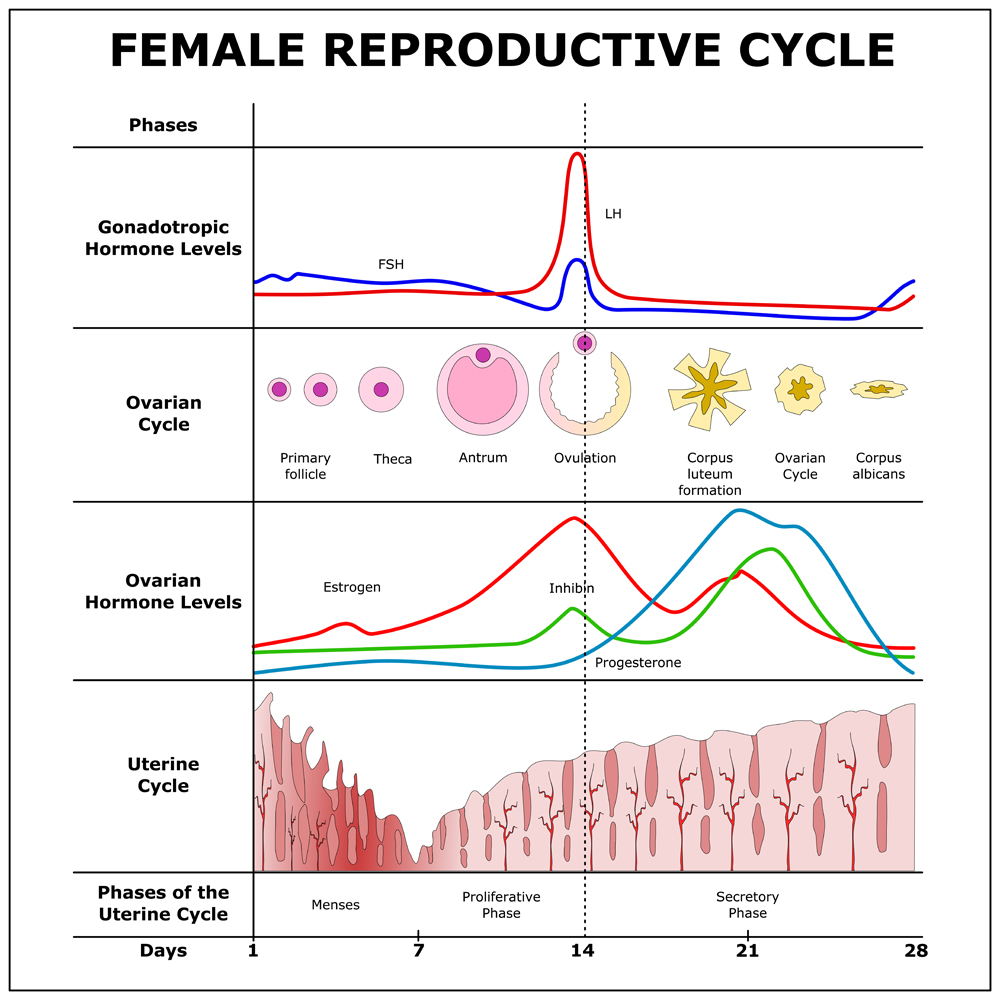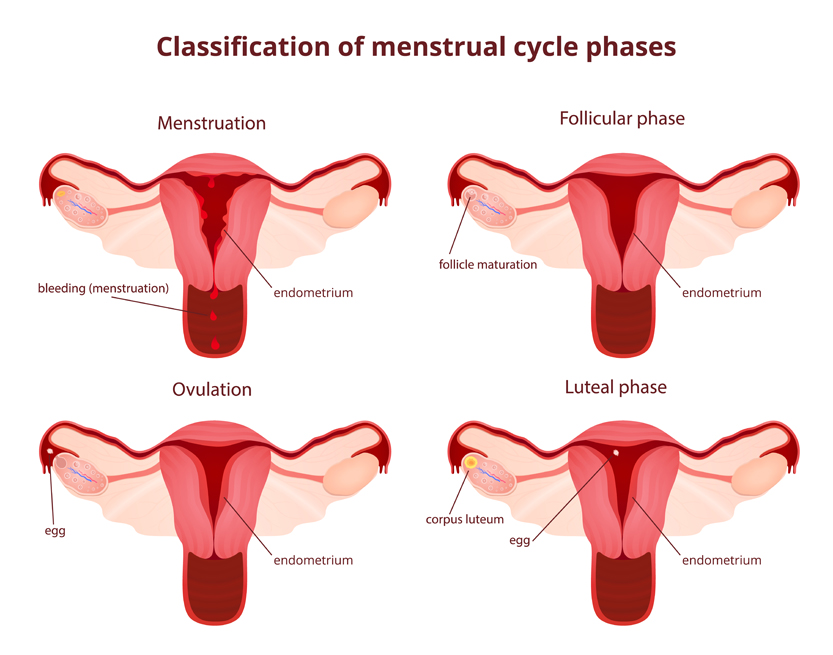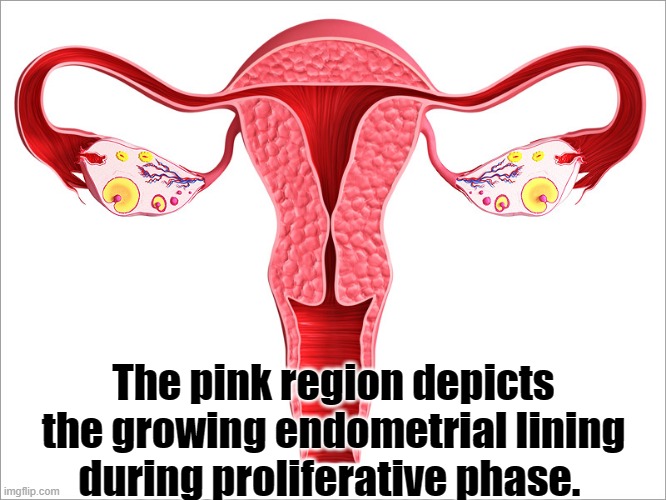Table of Contents (click to expand)
The menstrual cycle comprises four phases: the menstrual, the follicular, the ovulatory, and the luteal phases. The menstrual phase is when menstruation or bleeding occurs. The follicular phase is when the uterine lining regenerates (after being shed during the menstrual phase) or proliferates. The ovulatory phase is when the ovary releases the egg or ovum. The luteal phase is when the corpus luteum secretes a hormone called progesterone.
The menstrual cycle is a regular and entirely normal phenomenon in a woman’s life. The menstrual cycle comprises four phases: the menstrual, the follicular, the ovulatory, and the luteal phases.
The menses or periods begin in girls between the ages of 11-14. The onset of menstruation is called “menarche” and is a key sign of puberty. Regular menstruation usually stops between 45-55 years of age, beginning a period called “menopause”.
The menstrual cycle does not merely comprise a few days during which women experience bleeding. That duration is just one phase of the whole menstrual cycle. Typically, a menstrual cycle comprises 28 days, but this duration can also vary from woman to woman depending on factors such as genetics, lifestyle, and diet.

The menstrual cycle primarily involves the uterus and ovaries. The ovaries release an egg into the uterus every month. The uterus is a pear-shaped organ that acts as a cradle for the baby during the nine months it stays inside the mother’s body.
Just as humans sometimes feel “homesick”, the uterus feels “baby-sick”. In fact, the uterus becomes so “baby-sick” that it always prepares itself for a baby… every single month. When it doesn’t receive a baby, it takes down all its preparations, which it throws away. We recognize this releases in the form of menstrual blood.
The menstrual cycle comprises four phases—the menstrual phase, the follicular phase, the ovulatory phase, and the luteal phase, in that order.

The Menstrual Phase
The menstrual phase is usually considered the first phase of the cycle. It is during this phase that menstruation or bleeding occurs.
In preparation for a fetus, the uterus creates a lining called the endometrium composed of lots of soft tissues, cells, and mucus. This lining will provide the required conditions and nutrition for the fertilized egg to grow into a baby over the period of gestation. When it does not receive the baby, it sloughs off its endometrial lining.
Menstrual fluid comprises the removed endometrial tissue, mucus, and blood. It also includes some enzyme secretions and inflammatory exudates. And of course, the unused egg released from the ovary is also included in this menstrual fluid.
All of this is disposed through the vagina to the outside of the body. The vagina is a small canal that leads from the uterus and opens outside the body.
This phase normally lasts between 3-5 days, but can be as short as 2 days for some women or as long as 7 days for others. The amount of blood lost is usually about 30mL, but just like the menstrual cycle duration, the amount also varies from woman to woman. That said, blood loss of more than 80mL is abnormal.
The blood released during this phase isn’t like the blood running in our arteries and veins. This blood is darker in color, thicker in texture, and may also have an odor attached to it.
A common misconception is that menstruation depletes the blood flowing in the circulatory system, but one statistic shows that women on average only lose 60 milliliters (2.7 ounces).

Also, the blood doesn’t just continue dripping incessantly during these few days. It releases at intervals, which is where sanitary pads, tampons, or menstrual cups come to the rescue.
Also Read: Why Don’t Eyebrows And Eyelashes Grow As Long As Head Hair?
The Follicular Or Proliferative Phase
The follicular phase begins on the first day of menstruation. This is why the menstrual phase is sometimes included in this phase.
It is called the “proliferative phase” because the uterine lining regenerates (after being shed during the menstrual phase) or proliferates during this phase. The hormone estrogen is responsible for this “proliferation” of the endometrial lining. As depicted in the diagram above, the hormone estrogen gradually starts increasing during this phase.
The phase is also called follicular phase because of the development of follicles in the ovary. A follicle is a small pouch containing fluid and a developing egg. The primary follicles in the ovary grow to become fully mature Graafian follicles. The Graafian follicles, when mature, house a fully developed egg within them.
The follicular phase is also dependent on the follicle-stimulating hormone (FSH). It is under the effect of this hormone that the follicles develop and grow.

So, these two hormones, estrogen and FSH, continually increase in concentration during the follicular phase.
Also Read: Why Do We Lose Hair From Our Head, But Not The Rest Of Our Body?
The Ovulatory Phase
This is the shortest phase of the menstrual cycle, and lasts between 1-2 days. It more or less begins when the proliferation of the endometrium is complete. This phase is the prime time of the month for conceiving a baby.
A hormone called Luteinising Hormone (LH) is the reason behind the ovulatory phase. Levels of LH and FSH are high, which cause the following changes to occur.
As the name suggests, ovulation occurs during this phase, meaning that the ovary releases the egg or ovum. The Graafian follicle present in the ovary releases the matured egg (also called the oocyte). The Fallopian tubes connect the ovaries to the uterus. The finger-like projections at the end of the Fallopian tube pick up the ovum and transfer it to the uterus.
Changes to the cervix and uterus during this phase also make it easier for sperm to survive and travel up to the Fallopian tube, where it could fertilize the egg.
The Luteal Or Secretory Phase
This phase is the only phase with a fixed duration of 14 days in almost all women. The phase begins when the ovum has been released by the ovary into the Fallopian tube. The phase derives its name from the “corpus luteum”.
The corpus luteum is simply the leftovers of the Graafian follicle after it has released its egg. The remaining parts of the Graafian follicle then degrade further and transform into a yellow-colored substance. This can be seen in the diagram of the menstrual cycle above. And regarding the name, ‘corpus’ means body and ‘luteum’ means yellow. The Corpus luteum also secretes a hormone called progesterone.
Progesterone levels help in maintaining the thickened endometrial lining as it waits for the implantation of the zygote (that becomes a baby in the future) to occur. As long as the progesterone levels do not decline in the body, the endometrial lining does not slough off.
Naturally, right before the menses start, progesterone levels in the body drop. This happens because the corpus luteum—the source of progesterone—deteriorates. After that, the menstrual flow begins, starting the events of the menstrual cycle all over again.
The remaining corpus luteum degrades to corpus albicans and remains in the ovary as a scar or leftover tissue for a few months until the other cells (immune cells of the body) eat it up!
How well do you understand the article above!

References (click to expand)
- Menstrual cycle - Better Health Channel. betterhealth.vic.gov.au
- (2018) The Normal Menstrual Cycle and the Control of Ovulation - NCBI. The National Center for Biotechnology Information
- Menstrual Cycle - an overview | ScienceDirect Topics. ScienceDirect
- Bull, J. R., Rowland, S. P., Scherwitzl, E. B., Scherwitzl, R., Danielsson, K. G., & Harper, J. (2019, August 27). Real-world menstrual cycle characteristics of more than 600,000 menstrual cycles. npj Digital Medicine. Springer Science and Business Media LLC.
- Menstrual Cycle .pdf. The Ministry of Health
